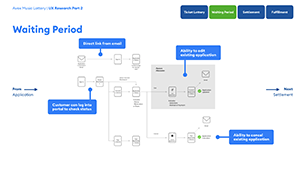Background
In Japan, music fans purchase tickets through a lottery system, which is different from what we’re used to in the US. This process is not one continuous experience. In several different distinct phases, customers apply for a lottery, receive word if they won seats, pay for their seats, and then finally await confirmation of the location of their seats.
To get the first access to these lotteries, customers belong to artist fan club, who do the work of publicizing the event (80% of music tickets are allocated to fanclubs). Customers are accustomed to navigating extensive rules before they can apply for tickets. Customers pay and pick up tickets in convenience stores (40% of all transactions).
Goal
Localize US-focused ticketing solution for the Japanese music market. We needed to understand the Japanese lottery system and weave it into our current ticketing flow.
Constraints
Initially I was contracted to this project to quickly build wireframes and deliver them to the UI design team. There were boundaries about what the product could become based off of the existing infrastructure.
Some of these constraints became opportunities. The client wanted to be more involved in the process, and I saw an opportunity to kickstart what later grew into my team’s ux research process.
Process
I began with client discussions about the scope of the project. I followed up with a more structured questionnaire to understand the current customer base, collect analytics, and understand who we were were targeting. I wanted a deeper understanding of their current customers and their behaviors.
I created ux artifacts such as personas, journey maps, needs and pain points (from both the client and customer perspective) to present and discuss, with the goal being alignment. I wanted to make sure we were all looking at the same problem.




To structure the client check-ins and assure them that they would be part of the process, I created three main phases of the research. Through these phases, I presented to the client reviewing ux artifacts, competitive/ competitive analysis, proposed sitemaps, wireframes, and prototypes. This gave the client regular opportunities for feedback and collaboration.

Through client discussions, I highlighted the benefits of conducting customer user testing. With even a small sample size of 10-15, we could raise our level of confidence in our proposed solution. I proposed a structure of how we could run quick qualitative usability sessions on the prototypes. With several open questions about the best way to present features, I propose developing two prototypes and testing both to determine a winner. The client agreed and we moved forward with the testing sessions.
I constructed a 10 page protocol walking the users through the prototype. In drafting this guide, I stategically paused at key moments during the walkthrough to dig deeper into their experiences and understand what they expect at certain points in the journey. Based off of primary and secondary personas, we set up guidelines for customer recruitment. Half of the recruits would be from the two primary personas. The other half would be spread among the secondary personas.
Working with a Japanese UX agency, I was able to prepare all the materials and they facilitated the 12 hour long sessions with Japanese customers.


Reviewing the annotated videos, I compiled feedback and pulled important quotes and themes uncovered in the conversations. I presented the findings to the client. In that report, I walked through the high level themes, specific feedback related to the prototype, short term improvements that could be made today, and long term improvements that we should be thinking about in future releases. It gave us a level of confidence in the current solution and provided a gameplay of how we move forward.




Results
This localized version of the purchase flow in currently in the final stages of development and QA with the first lottery scheduled for June.
Conclusion
This was a particularly fascinating project which solidified our ux research process. It gave me an opportunity to learn about the japanese culture, their norms, and customer expectations.
- We illuminated important cultural differences, defined a solution with group & client buy-in, and provided clear recommendations for future iterations.
- We increased client involvement turning the project into a conversation.
- We formalized UX Research process that has been scaled and adapted to many major company projects.
